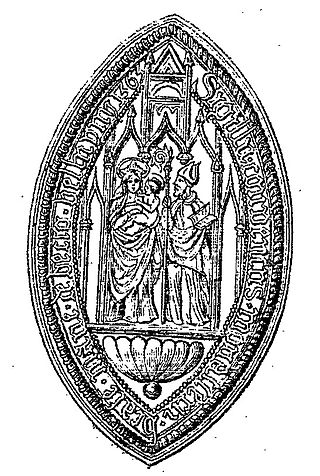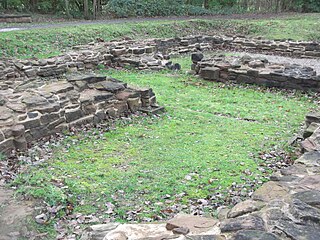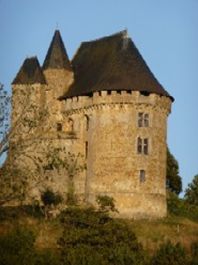Related Research Articles

Bec Abbey, formally the Abbey of Our Lady of Bec, is a Benedictine monastic foundation in the Eure département, in the Bec valley midway between the cities of Rouen and Bernay. It is located in Le Bec Hellouin, Normandy, France, and was the most influential abbey of the 12th-century Anglo-Norman kingdom.
The Lord High Chancellor of Ireland was the highest judicial office in Ireland until the establishment of the Irish Free State in 1922. From 1721 to 1801, it was also the highest political office of the Irish Parliament: the Chancellor was Speaker of the Irish House of Lords. The Lord Chancellor was also Lord Keeper of the Great Seal of Ireland. In all three respects, the office mirrored the Lord High Chancellor of Great Britain.
St Neots Priory was a Benedictine monastery beside the town of St Neots in the historic county of Huntingdonshire, now a non-metropolitan district in the English county of Cambridgeshire.

Sir John de Courcy (1150–1219) was an Anglo-Norman knight who arrived in Ireland in 1176. From then until his expulsion in 1204, he conquered a considerable territory, endowed religious establishments, built abbeys for both the Benedictines and the Cistercians and built strongholds at Dundrum Castle in County Down and Carrickfergus Castle in County Antrim.

Stogursey is a small village and civil parish in the Quantock Hills in Somerset, England. It is situated 3 miles (4.8 km) from Nether Stowey, and 8 miles (12.9 km) west of Bridgwater. The village is situated near the Bristol Channel, which bounds the parish on the north.
Robert fitz Martin was a knight from Devon whose father, Martin de Turribus, was the first Norman Lord of Kemes, in what had previously been the Dyfed part of Deheubarth. Fitz Martin inherited the Lordship of Kemes from his father, and founded St Dogmaels Abbey c. 1118. He was the first of the FitzMartin line. His descendants continued to hold lands in England and Wales until the 14th century.

The Church of St Andrew in Stogursey, Somerset, England dates from the early 12th century and has been designated as a Grade I listed building.

Stogursey Priory, also called Stoke Courcy Priory or The Priory of St Andrew de Stoke, was a Benedictine alien priory dedicated to St Andrew at Stogursey in Somerset, England. It was founded by William de Falaise, around 1100, to become a cell of Lonlay-l'Abbaye in Normandy. In around 1185 John de Courcy, its hereditary patron, founded the Priory of the Ards (Blackabbey) in County Down, Ireland, making an endowment of that estate to Stogursey Priory. The priory church survives as the parish church, and contains some of the original Norman architecture. Many of the priory's muniments are held in the archives of Eton College, which King Henry VI endowed with the appurtenances when the house was dissolved in about 1440.

Goldcliff Priory was a Benedictine monastery in Goldcliff, Newport, South Wales. It was established in 1113 by Robert de Chandos as a subsidiary house of the Abbey of Bec in Normandy. The priory was built on a coastal site, now the land of Hill Farm. In the 1950s, the Monmouthshire writer Hando noted the outlines of buildings visible as grass patterns or crop marks, but by the 1970s the only remaining structural element was part of a cellar in the farm house.

Little Dunmow Priory in Little Dunmow was an Augustinian priory in Essex, England. The priory was founded as a church by Juga de Baynard in 1104, dedicated to the Blessed Virgin Mary and consecrated by Maurice, bishop of London. Juga was the widow of Ralph Baynard, baron of Little Dunmow, sheriff of Essex and builder of Baynard's Castle in the City of London, since demolished. Her son Geoffrey was sheriff of Yorkshire who, in 1097, beat William II, Count of Eu in a trial by battle. After her death (c.1106), and following her wishes and the advice of Anselm, the Archbishop of Canterbury, Geoffrey populated Juga's church with Augustinian canons. In 1110, Lady Juga’s grandson, and Geoffrey’s son, William de Baynard, fell from grace and lost his lands. Henry I gave those lands to Robert Fitz Richard, but Henry and his wife Matilda of Scotland confirmed the canons’ possessions in Little Dunmow. Robert’s wife Maud, the step-daughter of Matilda’s brother David I, gave more lands to the canons, establishing the priory in perpetuity.

Sandwell Priory was a small medieval Benedictine monastery, near West Bromwich, then part of Staffordshire, England. It was founded in the late 12th century by a local landowner and was only modestly endowed. It had a fairly turbulent history and suffered considerably from mismanagement. It was dissolved in 1525 at the behest of Cardinal Wolsey – more than a decade before the main Dissolution of the Monasteries under Henry VIII.
Blakenham Priory was an estate in monastic ownership in the late Middle Ages, located at Great Blakenham in Suffolk, England.

Wynebald de Ballon, (c.1058–c.1126), was an early Norman magnate. He appeared in England during the reign of William Rufus, along with his brother, Hamelin de Ballon, later created 1st Baron of Abergavenny.
William de Falaise, also called William of Falaise, was a Norman from Falaise, Duchy of Normandy, today in the Calvados department in the Lower Normandy region of north-western France. He became feudal baron of Stogursey in Somerset and also held manors in Devon.
William de Courcy, feudal baron of Stoke Courcy in Somerset, was an Anglo-Norman nobleman.
William de Courcy was an Anglo-Norman nobleman and baron.
Sir Warin FitzGerold, also known as Sir Warin FitzGerald the Younger c.1167 – c.1218.
Stoke-by-Clare Priory was a Benedictine monastery in Stoke-by-Clare, in Suffolk, an alien priory, dependent on Bec Abbey, in Normandy. Reinstituted in 1124, the Priory was suppressed in 1415.
References
- 1 2 W. Kerr, 'Black Abbey, the archbishops of Armagh and the Church of Derryaghy', Lisburn Historical Society, Vol. 7 (1989), at Society's webpage, at note 6.
- ↑ G.E. Hamilton `Black Abbey', Journal of the Royal Society of Antiquaries of Ireland, Servo 6, vol. XI (1921), pp. 166-78 (Internet Archive).
- ↑ 'Alien house: The priory of Stogursey', in W. Page (ed.), A History of the County of Somerset, Vol. 2 (London, 1911), pp. 169-71 (British History Online).
- ↑ M. Baylé, 'Les chapiteaux de Stogursey (Somerset), ancien prieuré de Lonlay-l'Abbaye', Bulletin Monumental, Vol 138 Part 4 (1980), pp. 405-16 (Persée). In French.
- ↑ C. Gathercole, An Archaeological Assessment of Stogursey, Somerset Urban Archaeology Surveys (English Heritage Extensive Urban Surveys/Somerset County Council 2003), with link to full report (SW South-West Heritage Trust).
- ↑ T.D. Tremlett and N. Blakiston (eds), Stogursey Charters. Charters and other Documents relating to the property of the Alien Priory of Stogursey, Somerset, Somerset Record Society LXI (1949), pp. 50-51.
- ↑ W. Dugdale, ed. J. Caley, H. Ellis and B. Bandinel, Monasticon Anglicanum Vol. 6 Part 2 (James Bohn, London 1846), p. 1123, no. I (Google).
- ↑ Dugdale, Monasticon, Vol. 6 Part 2 (1846), p. 1123, no. II (Google).
- ↑ Inspeximus in Patent Roll 12 Richard II, no. 123 (1388-1389), "Calendar of Irish Chancery Letters c. 1244-1509", CIRCLE (Trinity College, Dublin).
- ↑ M. Archdall, ed. P.F. Moran, Monasticon Hibernicum: A History of the Abbeys, Priories, and Other Religious Houses in Ireland, 3 vols (W.B. Kelly, Dublin 1873), I, pp. 237-39, in notitiis (Google).
- ↑ Patent Roll 12 Richard II, no. 231 (8 December 1388), "Calendar of Irish Chancery Letters c. 1244-1509", CIRCLE (Trinity College, Dublin).